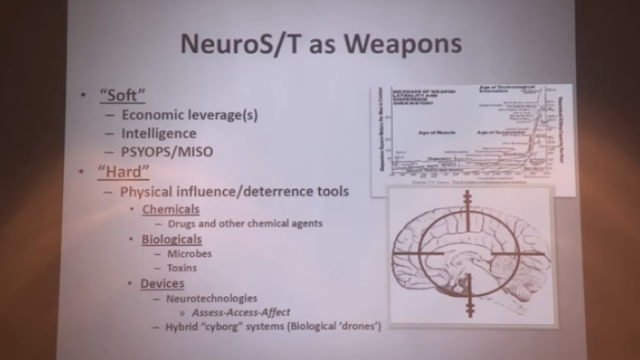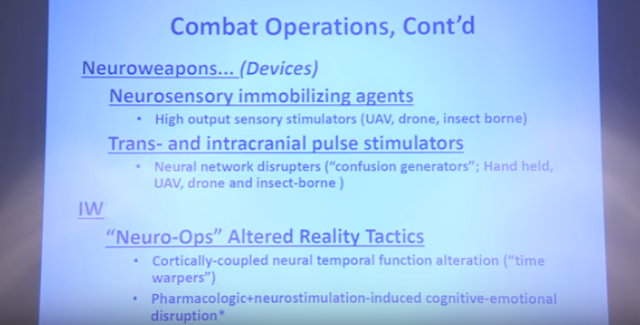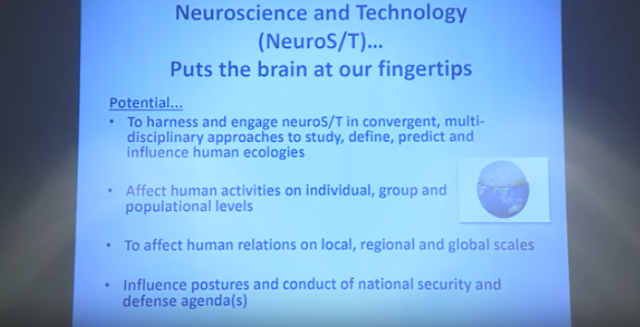SUBNETS is inspired by Deep Brain Stimulation (DBS), a surgical treatment that involves implanting a brain pacemaker in the patient’s skull to interfere with brain activity to help with symptoms of diseases like epilepsy and Parkinson’s. DARPA’s device monitors and analyze data in real time and issues a specific intervention according to brain activity.
This kind of technology is being developed by the private sector as well. In fact, according to Scientific American scientists are becoming increasingly excited about how brain implants can be used to “reboot” the brains of people with depression… Psychological depression is more than an emotional state. Good evidence for that comes from emerging new uses of a technology already widely prescribed for Parkinson’s patients. The more neurologists and surgeons learn about the aptly named deep brain stimulation, the more they are convinced that the currents from the technology’s implanted electrodes can literally reboot brain circuits involved with the mood disorder. Psychological depression is more than an emotional state. Good evidence for that comes from emerging new uses of a technology already widely prescribed for Parkinson’s patients.
The more neurologists and surgeons learn about the aptly named deep brain stimulation, the more they are convinced that the currents from the technology’s implanted electrodes can literally reboot brain circuits involved with the mood disorder. U.S. president Barack Obama formally announced the federal project in April 2013 with a US $110 million first-year budget that will be parceled out to the National Institutes of Health (NIH), the National Science Foundation (NSF), and the Defense Advanced Research Projects Agency (DARPA). Four private institutions—the Kavli Foundation,
Allen Institute for Brain Science, Howard Hughes Medical Institute, and Salk Institute for Biological Studies—have also committed a total of $122 million of their own money to BRAIN work in 2014. Over the next year, the BRAIN Initiative should coalesce into one of the century’s defining scientific projects.
Science takes on the human brain
Despite the “best efforts” of the Departments of Defense and Veterans Affairs to “protect the health” of U.S. servicemembers and veterans, the effects of Neuropsychology illness brought on by war, traumatic injuries and other experiences are not always easily treated. While current approaches can often help to alleviate the worst effects of these illnesses, they are imprecise and not universally effective. Demand for new therapies is high as mental disorders are the leading cause of hospital bed days and the second leading cause of medical encounters for active duty servicemembers. Among veterans, ten percent of those receiving treatment from the Veterans’ Health Administration are provided mental health care or substance abuse counseling.
DARPA created the Systems-Based Neurotechnology for Emerging Therapies (SUBNETS) program to pursue advances in neuroscience and neurotechnology that could lead to new clinical understanding of how neuropsychological illnesses manifest in the brain and to advanced therapies to reduce the burden and severity of illness in afflicted troops and veterans [You know, like killing and torturing people]. The program will pursue a new investigative approach that establishes the characteristics of distributed neural systems and attempts to develop and apply therapies that incorporate near real-time recording, analysis and stimulation in next-generation devices inspired by current Deep Brain Stimulation (DBS).
DBS already exists as a therapy option for certain neurologic and neuropsychological illnesses in patients who are not responsive to other therapies. “Approximately” 100,000 people around the globe live with a DBS implant, a device that delivers electrical stimulation to reduce the motor impairment caused by Parkinson’s disease and dystonia. These devices are also being studied as therapy for depression, obsessive compulsive disorder, Tourette’s and epilepsy.
SUBNETS seeks to move beyond this limited understanding to create new interventions based on new insights that can be gained from the intersection of neuroscience, neurotechnology and clinical therapy. While there is no question that brain activity, anatomy and behavior are functionally linked, there is a growing body of evidence to suggest that many neural and behavioral processes are not localized to specific anatomical regions, but are emergent from systems that span several regions of the brain. SUBNETS attempts to establish the capability to record and model how these systems function in both normal conditions, among “volunteers” seeking treatment for “unrelated neurologic disorders,” as well as among impaired clinical research participants.
DARPA is specifically interested in evaluating the underlying systems which contribute to the following conditions as described by the Diagnostic and Statistical Manual of Mental Disorders: Post-Traumatic Stress Disorder, Major Depression, Borderline Personality Disorder and General Anxiety Disorder. DARPA also seeks to evaluate the representation in the central nervous system of: Traumatic Brain Injury, Substance Abuse/Addiction and Fibromyalgia/Chronic Pain.
SUBNETS advances neuropsychiatry “beyond the realm of dialogue-driven observations and resultant trial and error and into the realm of therapy driven by quantifiable characteristics of neural state,” said Justin Sanchez, DARPA program manager. “SUBNETS is a push toward innovative, informed and precise neurotechnological therapy to produce major improvements in quality of life for servicemembers and veterans who have very few options with existing therapies. These are patients for whom current medical understanding of diseases like chronic pain or fatigue, unmanageable depression or severe post-traumatic stress disorder can’t provide meaningful relief.”
As described in a broad agency announcement, the work will require development of novel medical hardware, complex modeling of human neural systems, clinical neurology and animal research. DARPA expects that successful teams will span across disciplines including psychiatry, neurosurgery, Neural Engineering, Microelectronics, neuroscience, statistics and computational modeling.
“We’re talking about a whole systems approach to the brain, not a disease-by-disease examination of a single process or a subset of processes,” Sanchez said. “SUBNETS is going to be a cross-disciplinary, expansive team effort and the program will integrate and build upon historical DARPA research investments.”
Because programs like SUBNETS push the leading edge of science, they are sometimes society’s first encounter with the dilemmas associated with new technologies. DARPA pursues these technologies because of their promise, but the Agency understands that it is important to “consider ethical, legal, societal and policy” questions. For that reason, DARPA has convened an Ethical, Legal and Social Implications (ELSI) panel to inform and advise SUBNETS and other emerging neuroscience efforts. The panel’s membership represents the academic community, medical ethicists, and clinical and research scientists. ELSI panelists provides guidance in addition to the standard oversight provided by DARPA and Department of Defense internal review boards that govern human and animal use and the Presidential Commission for the Study of Bioethical Issues that oversees SUBNETS as part of the BRAIN Initiative.


































































No comments:
Post a Comment